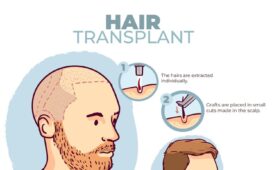Hair treatments depend on technology in the form of transplants and hair extensions. During a hair transplant surgery, the doctor takes hair from the sides, or back of the head and places it on the bald area. The surgeon administers hair transplant surgery in the clinic after giving a local anaesthesia to the patient. According to research, baldness often occurs due to genetics. But, some other factors also cause baldness like illness stress, unhealthy diet, and some drugs.
There are two types of transplants; micro grafts and skin grafts.
The micro graft process involves one hair in a graft and in some cases two hairs. A transplant can alter your appearance creating more confidence and self-esteem in you.
The slit graft process includes several hairs in the graft, usually from 4 to 10. However, the extent of the baldness also determines the amount of hairs.
Medici Capelli is one of the only clinics that specialise full-time in non-surgical and surgical hair loss treatments for men and women. To achieve the most natural results, Medici Capelli hair transplant uses zig-zag patterns rather than round or straight lines to create a natural hairline the way your hairline used to be.
Who Can Have a Hair Transplant?
Both women and men can have a hair transplant; if men have male-style baldness, and women have thin hair.
The hair transplant procedure normally takes three to four sessions to achieve the desired results. Surgeons leave a gap of several months between the sessions to ensure a good transplant.
Who Shouldn’t Have a Hair Transplant?
- Women or men without any good donor sites.
- Women who have hair loss in the entire scalp.
- Women or men who lose their hair as a result of taking drugs, especially when having chemotherapy.
- Women or men with injury scars or who have had deep surgery.
Things to Consider Post Surgery
- Most patients experience soreness in the scalp following the transplant, and some require medications to manage pain, for infection or swelling. Following a successful hair transplant, the individual can begin living a normal life.
- Transplanted hair can fall after 2 or 3 weeks of surgery due to the fact that it sets the ground for new hair. Many patients see a 60 percent hair growth after 6 or 9 months of surgery.
- Surgeons can also prescribe a variety of drugs for fast hair growth, and to prevent the patient from any future hair loss.
Possible Risks
Hair transplants also have some side-effects that disappear after a few weeks. Some common complications include bruising, swelling and infection near the eyes, and scars on the treated area. Numbness often happens in the treated area, but its temporary. Other side-effects include itching, inflammation, and an interim shock loss of hair.
Long-Term Benefits
Constant hair growth occurs after the transplant, but the hair thickness and quality depend on individual elements including follicles’ density, scalp laxity, and curls. Hair transplant patients should discuss with their surgeon about the long-term appearance following surgery.













